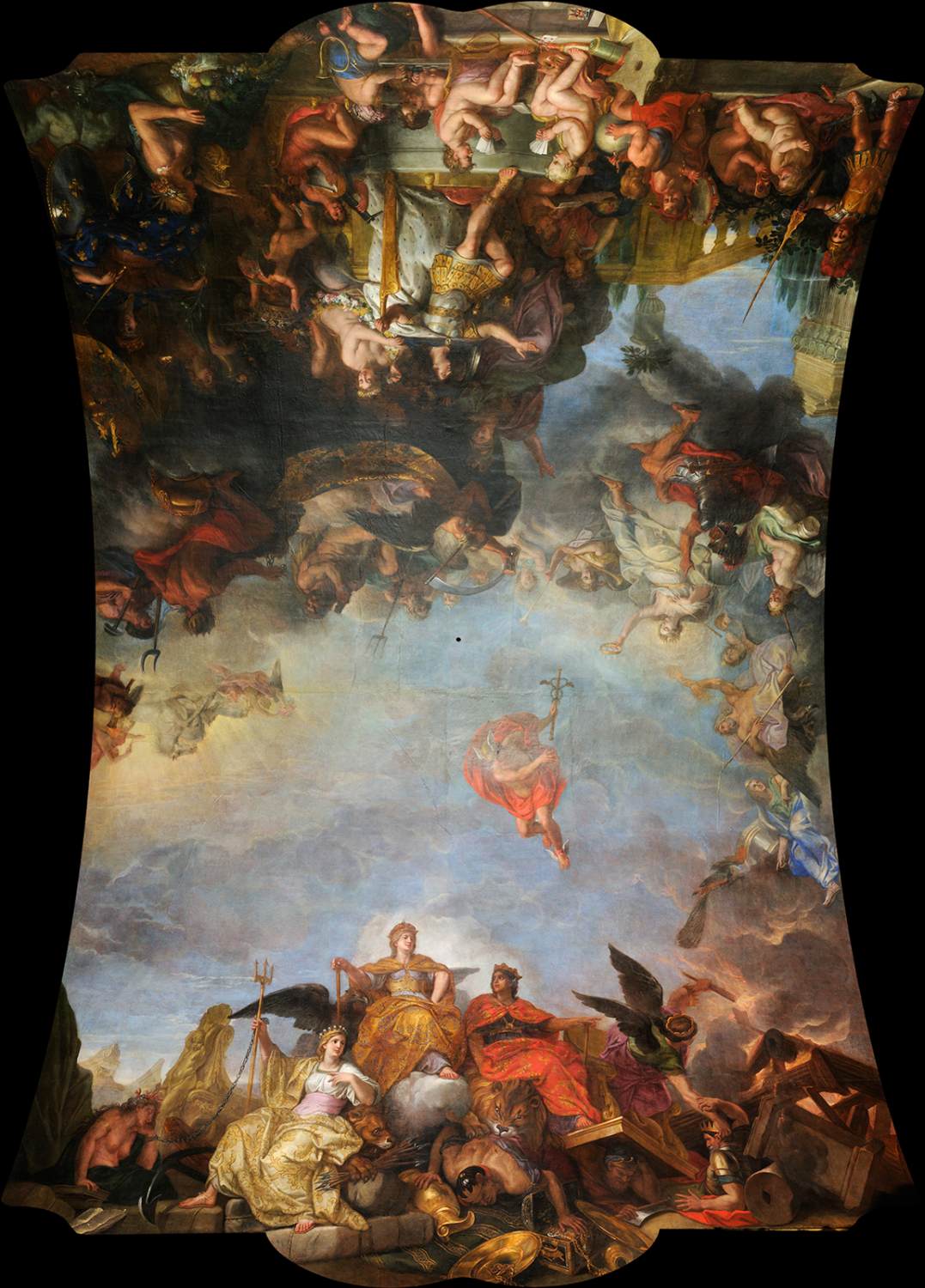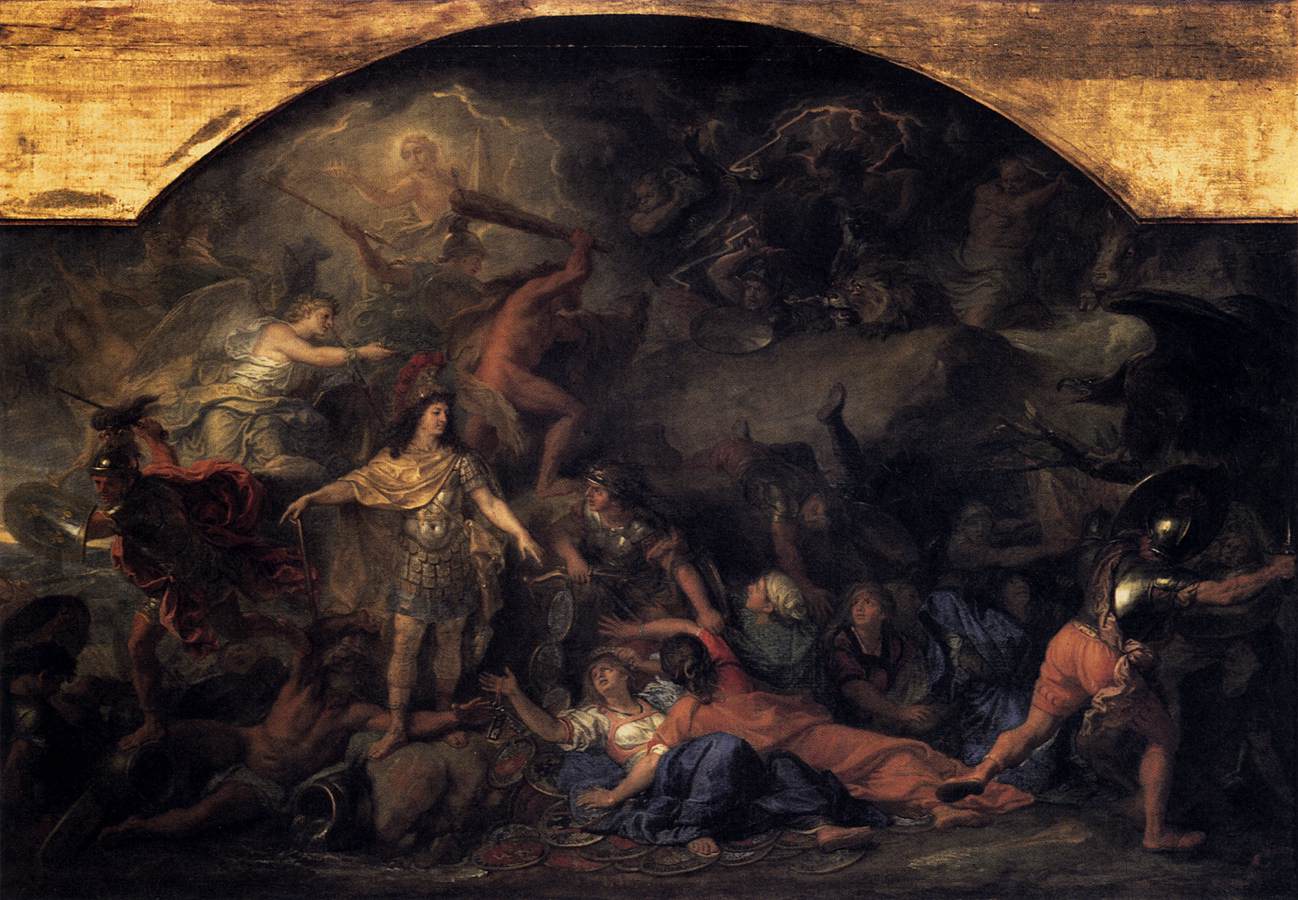French painter and art theorist, the dominant artist of Louis XIV's reign. His father, the sculptor Nicolas Le Brun the Elder, sent him at a very young age to study under François Perrier, and later under Simon Vouet. Le Brun copied various paintings at Fontainebleau and from the age of 15, painted several compositions for Cardinal Richelieu; Poussin, who was then in Paris, found them interesting.
Le Brun's output was prolific. When he was not painting, he produced etchings, drawings based on doctrines, and wax models. Chancellor Séguier, who was his faithful protector, paid him a salary so that in 1642 he could go to Italy, and entrusted him to Poussin, who was returning to Rome. Le Brun worked under Poussin, becoming a convert to the latter's theories of art.
In 1646, Le Brun went back to France, settled in Lyons where he produced a number of works and returned to Paris with the reputation of an accomplished artist. From then on he was overwhelmed with commissions. In 1647, he painted Martyrdom of St Andrew for the goldsmiths, which was designed for Notre-Dame. In 1648, he took an active part in the establishment of the academy, where he was a dominant force until the end of his career. In 1649, he collaborated with Le Sueur on the decoration of l'Hôtel Lambert. Minister of Finance Nicolas Fouquet paid him a salary of 12,000 livres and put him in charge of the decoration of his château at Vaux (Vaux-le-Vicomte). Le Brun met Cardinal Mazarin at Fouquet's château, who presented him to Louis XIV and the queen mother. She commissioned a painting of Christ with Angels for his chapel, which enjoyed considerable success. Le Brun was commissioned to decorate Place Dauphine after the king's marriage to the Infanta Maria Teresa (daughter of the King of Spain, Philip IV).
In 1660, the king who was at Fontainebleau, commissioned him to paint several subjects on the history of Alexander. In the presence of Louis XIV, Le Brun painted The Family of Darius; the sovereign was so satisfied with it that he offered the painter his portrait enriched with diamonds and appointed him as premier peintre ('First Painter to the King') in July 1662 with a salary of 12,000 livres.
In 1662 he was raised to nobility. The king put him in charge of his pictures and drawings, with the task of buying painting and sculpture that he deemed worthy of enriching the royal collection. The fire in the painting gallery at the Louvre, on 6 February 1661, provided Le Brun with the opportunity to express his talent as a great decorator. He designed the general plan for the Galerie d'Apollon, producing all the designs for paintings, sculptures, and ornaments, but he only painted four pieces. As the creation of Versailles absorbed the attention of the sovereign, the works to be carried out at the Louvre were postponed.
In 1663 he was made director of the reorganized Gobelins factory, where there was a network of workshops supplying tapestries, furniture, gold work and silverware, locksmiths, mosaics, and the Crown's marquetry. Le Brun's influence here was considerable. He designed everything and supervised production.
Also in 1663 he was made director of the reorganized Académie, which he turned into a channel for imposing a codified system of orthodoxy in matters of art. His lectures came to be accepted as providing the official standards of artistic correctness and, formulated on the basis of the classicism of Poussin, gave authority to the view that every aspect of artistic creation can be reduced to teachable rule and precept.
In 1666, Le Brun used his influence to establish a French School in Rome. In 1677, we find him accompanying the king during the Flanders campaign and on his return producing paintings at the Château de St-Germain. The previous year, the Accademia de San Luca, in Rome, had elected him principal and director. In spite of the pictures painted for Louis XIV and the many designs for statues in the park at Versailles, Le Brun still found the time to decorate a château for Colbert and the Pavillons de Sceaux. The indefatigable artist also painted the façades for the Pavillons de Marly and the Great Staircase at Versailles. In 1679, he undertook the painting and decoration of the Galerie des Glaces ('Hall of Mirrors') at Versailles, a colossal room exceeding 80 metres x 12 metres. Le Brun devoted four years to it, painting Louis XIV in various guises in 21 pictures and 6 low reliefs. He also decorated the Salon de la Paix ('Salon of Peace') at one end and the Salon de la Guerre ('Salon of War') at the other end of the gallery.
Colbert's death was a terrible blow to Le Brun's career. Louvois hated everything his predecessor had nurtured. In his official capacity as Superintendent of Buildings, Louvois could create a multitude of impediments and many obstacles for Le Brun. Until then, the painter, who reigned supreme, had dictated all artistic matters; which, although he bestowed a majestic unity on the formal beauty of Louis XIV's reign and had banned any originality diverging from the orthodoxy defined by the academy, he had compromised the artistic evolution of the period. Silent opposition and Louvois's criticism affected Le Brun's health, probably already exhausted by the relentless efforts that these works demanded. He stopped going to the Court, in spite of the favour the king had always shown him, and a decline ended his life.
Despite the classicism of his theories, Le Brun's own talents lay rather in the direction of flamboyant and grandiose decorative effects. Among the most outstanding of his works for the king were the Galerie d'Apollon at the Louvre (1663), and the famous Galerie des Glaces (1679-84) and the Great Staircase (1671-78, destroyed in 1752) at Versailles.
His importance in the history of French art is twofold: his contributions to the magnificence of the Grand Manner of Louis XIV and his influence in laying the basis of academicism. Many of the leading French artists of the next generation trained in his studio. Le Brun was a fine portraitist and an extremely prolific draughtsman.
//
![]()









